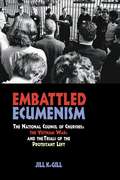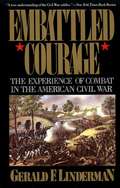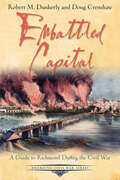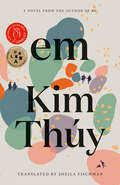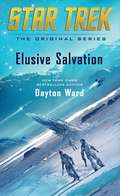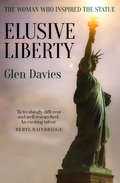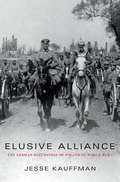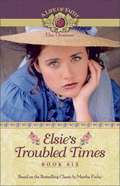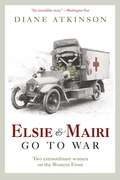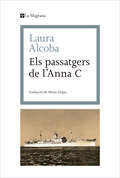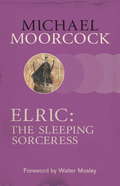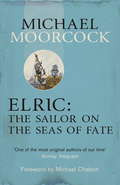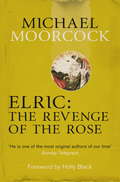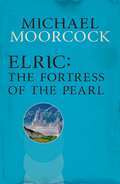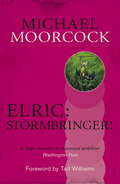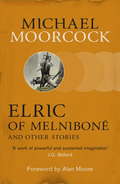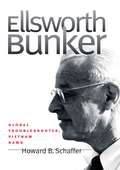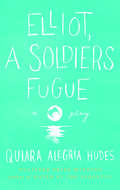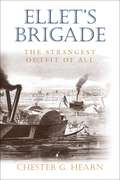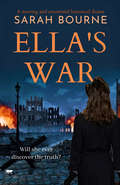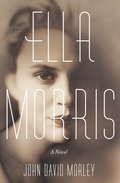- Table View
- List View
Embattled Ecumenism: The National Council of Churches, the Vietnam War, and the Trials of the Protestant Left
by Jill K. GillThe Vietnam War and its polarizing era challenged, splintered, and changed The National Council of the Churches of Christ in the U. S. A. (NCC), which was motivated by its ecumenical Christian vision to oppose that war and unify people. The NCC's efforts on the war exposed its strengths and imploded its weaknesses in ways instructive for religious institutions that bring their faith into politics. Embattled Ecumenism explores the ecumenical vision, anti-Vietnam War efforts, and legacy of the NCC. Gill's monumental study serves as a window into the mainline Protestant manner of engaging political issues at a unique time of national crisis and religious transformation. In vibrant prose, Gill illuminates an ecumenical institution, vision, and movement that has been largely misrepresented by the religious right, dismissed by the secular left, misunderstood by laity, and ignored by scholars outside of ecumenical circles. At a time when the majority of scholarly work is committed to looking at the religious right, Gill's groundbreaking study of the Protestant Left is a welcome addition. Embattled Ecumenism will appeal to scholars of U. S. religion, politics, and culture, as well as historians of evangelicalism and general readers interested in U. S. history and religion.
Embattled Courage: The Experience of Combat in the American Civil War
by Gerald F. LindermanLinderman traces each soldier's path from the exhilaration of enlistment to the disillusionment of battle to postwar alienation. He provides a rare glimpse of the personal battle that raged within soldiers then and now.
Embattled Capital: A Guide to Richmond During the Civil War (Emerging Civil War Series)
by Robert M. Dunkerly Doug CrenshawA guide to the former Confederate capital of Richmond, Virginia, with “a good deal of historical information, much of it neglected in histories of the war” (The NYMAS Review).“On To Richmond!” cried editors for the New York Tribune in the spring of 1861. Thereafter, that call became the rallying cry for the North’s eastern armies as they marched, maneuvered, and fought their way toward the capital of the Confederacy.Just 100 miles from Washington, DC, Richmond served as a symbol of the rebellion itself. It was home to the Confederate Congress, cabinet, president, and military leadership. And it housed not only the Confederate government but also some of the Confederacy’s most important industry and infrastructure. The city was filled with prisons, hospitals, factories, training camps, and government offices.Through four years of war, armies battled at its doorsteps—and even penetrated its defenses. Civilians felt the impact of war in many ways: food shortages, rising inflation, a bread riot, industrial accidents, and eventually, military occupation. To this day, the war’s legacy remains deeply written into the city and its history.This book tells the story of the Confederate capital before, during, and after the Civil War, and serves as a guidebook including a comprehensive list of places to visit: the battlefields around the city, museums, historic sites, monuments, cemeteries, historical preservation groups, and more.
Emanuel, or Children of the Soil
by Henrik PontoppidanImmerse yourself in the profound and evocative world of rural Denmark with Henrik Pontoppidan's Emanuel, or Children of the Soil. This literary masterpiece, written by one of Denmark’s most celebrated authors and a Nobel Prize laureate, offers a compelling exploration of the human condition, societal struggles, and the timeless connection between people and the land they inhabit.Set against the backdrop of the Danish countryside, Emanuel, or Children of the Soil follows the life of Emanuel Hansted, a young idealist with a deep love for nature and a passion for social justice. Emanuel's journey is one of personal growth and disillusionment as he confronts the harsh realities of rural life and the complexities of human nature.Pontoppidan’s rich and nuanced narrative delves into the lives of the rural community, portraying their joys, sorrows, and enduring spirit with great empathy and detail. Through Emanuel's interactions with the villagers, Pontoppidan examines themes of tradition, progress, and the inevitable conflicts that arise when old ways meet new ideas.The novel is a vivid portrayal of the socio-economic changes occurring in late 19th-century Denmark, capturing the tensions between the agrarian past and the industrial future. Pontoppidan's exquisite prose brings the Danish landscape to life, painting a vivid picture of the fields, forests, and farms that shape the characters' lives and destinies.Emanuel, or Children of the Soil is more than just a story of one man's journey; it is a reflection on the broader human experience, exploring universal themes of hope, struggle, and the quest for meaning. Pontoppidan’s deep philosophical insights and his ability to convey the inner lives of his characters make this novel a timeless and thought-provoking read.
Em
by Kim ThúyLONGLISTED FOR THE 2021 SCOTIABANK GILLER PRIZE Kim Thúy's Em is a virtuosic novel of profound power and sensitivity, and an enduring affirmation of the greatest act of resistance: love.In the midst of war, an ordinary miracle: an abandoned baby tenderly cared for by a young boy living on the streets of Saigon. The boy is Louis, the child of a long-gone American soldier. Louis calls the baby em Hồng, em meaning "little sister," or "beloved." Even though her cradle is nothing more than a cardboard box, em Hồng's life holds every possibility. Through the linked destinies of a family of characters, the novel takes its inspiration from historical events, including Operation Babylift, which evacuated thousands of biracial orphans from Saigon in April 1975, and the remarkable growth of the nail salon industry, dominated by Vietnamese expatriates all over the world. From the rubber plantations of Indochina to the massacre at My Lai, Kim Thúy sifts through the layers of pain and trauma in stories we thought we knew, revealing transcendent moments of grace, and the invincibility of the human spirit.
Elvis’s Army
by Brian Mcallister LinnWhen the Army drafted Elvis in 1958, it set about transforming the King of Rock and Roll from a rebellious teen idol into a clean-cut GI trained for nuclear warfare. Brian Linn traces the origins, evolution, and ultimate failure of the army's attempt to reinvent itself for the Atomic Age, and reveals the experiences of its forgotten soldiers.
Elusive Salvation (Star Trek: The Original Series)
by Dayton WardAn all-new Star Trek adventure across time—the latest of the acclaimed Original Series novels!The Arctic Circle, 1845: Escaping the tyranny under which their people have lived for generations, aliens from a distant planet crash land on Earth’s inhospitable frozen wastes. Surviving the harsh conditions will pose a challenge, but over time the aliens will migrate to more populated areas, with decades passing as they work to conceal their presence from their former oppressors, who continue to hunt them at any cost. San Francisco, 2283: When a mysterious craft is detected entering the solar system, Admiral James Kirk is dispatched by Starfleet to confront the vessel. He meets with an emissary from the Iramahl, a previously unknown alien race who have come in search of their brothers and sisters thought to have gone missing in this area of space centuries earlier. Having recently thrown off the last chains of subjugation by another species, the Ptaen, they now believe their lost people hold the key to saving their entire race from eventual extinction. New York, 1970: Roberta Lincoln, young protégé of the mysterious agent Gary Seven, is shocked when she receives the oddest request for help—from the future… ™, ®, & © 2016 CBS Studios, Inc. STAR TREK and related marks are trademarks of CBS Studios, Inc. All Rights Reserved.
Elusive Liberty: The Woman Who Inspired the Statue
by Glen DaviesThe woman immortalized as the Statue of Liberty comes to life in this “refreshingly different and well researched” novel of nineteenth century France (Beryl Bainbridge, author of The Dressmaker). France, 1867. The elite of the world have come to Paris for the Great Exhibition, where they can enjoy the sophistication of the French Empire of Napoleon III. At the Imperial court, young Jeanne-Emilie de Lamont meets the man who will change her life: Frederic Bartholdi, the Republican sculptor who finds in her the inspiration for his greatest creation. When France and Prussia go to war, Emilie’s world is thrown into turmoil. As Bismarck’s army surrounds Paris, she sees a side of the city—and of herself—she never before imagined. While Paris reels under the twin blows of war and revolution, Frederic’s hopes for his Statue of Liberty are under threat. It will take a new continent, and an old dream, to save it. But can he save the girl who was Liberty? A sweeping historical epic, Elusive Liberty takes the reader from the splendor of the Great Paris Exhibition to the Pyramids of Egypt, from the Franco-Prussian War to Philadelphia’s Centennial Exhibition in 1876. “An exciting talent.” —Beryl Bainbridge, author of Master Georgie
Elusive Alliance: The German Occupation of Poland in World War I
by Jesse KauffmanJesse Kauffman explains why Germany's ambitious attempt at nation-building in Poland during WWI failed. The educational and political institutions Germany built for its satellite state could not alleviate Poland's hostility to the plundering of its resources to fuel Germany's war effort.
Elsie's Troubled Times (Book Six of the Elsie Dinsmore: A Life of Faith Series)
by Martha Finley Mission City Press"But the newspapers say it cannot last long, Papa, three months at most," Elsie interjected. "The newspapers are wrong," Horace replied forcefully. "This is American against American, and neither side will be easily defeated," Edward said. Sadly, Horace added, "We must prepare ourselves to wait out a long and bitter conflict. When we next see our homeland, all will be changed forever." Elsie's life seems nearly perfect when she returns home from her honeymoon. But not even the true love of husband and family can shelter her from the great upheaval that lies ahead. They are soon caught up in the bitter struggles between North and South. When the nation is torn apart, how will Elsie and her loved ones deal with its tragedies? Who will survive? "Elsie's Troubled Times", the sixth book of the "Elsie Dinsmore: A Life of Faith" series, takes its heroine into one of the darkest periods of American history, the Civil War. As the war pits brother against brother on the battlefields, Elsie's ideals, loyalties, and even her Christian faith are threatened. "Elsie's Troubled Times", adapted from the 19th century novels written by Martha Finley, is a life-and-death story sure to grip the heart of every reader.
Elsie and Mairi Go to War: Two Extraordinary Women on the Western Front
by Diane AtkinsonThe incredible story of two courageous and spirited women who were the only female participants to serve on the western front during World War I. When they met at a motorcycle club in 1912, Elsie Knocker was a thirty year-old motorcycling divorcee dressed in bottle-green Dunhill leathers, and Mairi Chisholm was a brilliant eighteen-year old mechanic, living at home borrowing tools from her brother. Little did they know, theirs was to become one of the most extraordinary stories of World War I. In 1914, they roared off to London 'to do their bit,' and within a month they were in the thick of things in Belgium driving ambulances to distant military hospitals. Frustrated by the number of men dying of shock in the back of their vehicles, they set up their own first-aid post on the front line in the village of Pervyse, near Ypres, risking their lives working under sniper fire and heavy bombardment for months at a time. As news of their courage and expertise spread, the 'Angels of Pervyse' became celebrities, visited by journalists and photographers as well as royals and VIPs. Glamorous and influential, they were having the time of their lives, and for four years Elsie and Mairi and stayed in Pervyse until they were nearly killed by arsenic gas in the spring of 1918. But returning home and adjusting to peacetime life--and the role of women in British society--was to prove more challenging than even the war itself.
Els passatgers de l'Anna C.
by Laura AlcobaEls passatgers de l'Anna C. relata l'increïble viatge realitzat per un grapat de joves revolucionaris argentins a mitjans dels anys seixanta, amb la finalitat d’unir-se al Che Guevara. Estan preparats per donar la seva vida per la Revolució. L’any 1968 el vaixell Anna C. Portava en Manel i la Soledad de tornada a l’Argentina, després de dos anys d’entrenament guerriller a Cuba. Amb ells, hi havia la seva filla acabada de néixer. Llavors duia un altre nom, però és la mateixa Laura Alcoba, l’autora i narradora d’aquesta novel·la, que, passats els anys, ressegueix el periple dels seus pares i altres companys argentins, els quals, enduts per l’ideal revolucionari, van viatjar a Cuba per unir-se al Che i la revolució. Sota l’aspecte d’una investigació que duu a terme l’autora, preguntant als seus pares i als supervivents, i recreant brillantment l’experiència guerrillera dels protagonistes i l’ambient intel·lectual revolucionari, Els passatgers de l’Anna C. és una novel·la escrita amb tant de reconeixement com de distanciat i amable escepticisme, una novel·la feta de petits moments reveladors i escenes on conviuen les il·lusions invencibles de la joventut amb el trencament -pot ser inevitable- que experimenten els somnis en contacte amb la realitat.
Elric: The Sleeping Sorceress
by Michael MoorcockGollancz is very proud to present the author's definitive editions of the saga of Elric, the last emperor of Melniboné. Michael Moorcock and his long-time friend and bibliographer John Davey have collaborated to produce the most consistent and coherent narrative from the disparate novels, novellas, short stories and non-fiction about Elric. From his early life in Melniboné all the way through to his final days, these seven volumes will be the definitive telling of the albino prince's story. Elric is one of the great creations of modern fantasy, and has inspired legions of imitators. If you know his story already, then this definitive edition will finally let you read the entire saga in the author's preferred order. If you've never experienced the chronicles of the albino with the soul-sucking sword, then this is the perfect place to start.Containing stories, novellas, supplementary material and commentary, these editions of ELRIC are the finest yet.
Elric: The Sailor on the Seas of Fate
by Michael MoorcockGollancz is very proud to present the author's definitive editions of the saga of Elric, the last emperor of Melniboné. Michael Moorcock and his long-time friend and bibliographer John Davey have collaborated to produce the most consistent and coherent narrative from the disparate novels, novellas, short stories and non-fiction about Elric. From his early life in Melniboné all the way through to his final days, these seven volumes will be the definitive telling of the albino prince's story. Elric is one of the great creations of modern fantasy, and has inspired legions of imitators. If you know his story already, then this definitive edition will finally let you read the entire saga in the author's preferred order. If you've never experienced the chronicles of the albino with the soul-sucking sword, then this is the perfect place to start.Containing stories, novellas, supplementary material and commentary, these editions of Elric are the finest yet.
Elric: The Revenge of the Rose
by Michael MoorcockFeared by enemies and friends alike, Elric of Melnibone walks a lonely path among the worlds of the multiverse. The destroyer of his own cruel and ancient race, as well as its final ruler, Elric is the bearer of a destiny as dark and cursed as the vampiric sword he carries - the sentient black blade known as Stormbringer.The soul of Elric's father is tortured and suffering. To free it, Elric must face the princes of hell, and put all of his trust in one woman - the Rose.With an introduction by Holly Black, and containing THE REVENGE OF THE ROSE as well as associated short stories, this collection presents Moorcock's greatest creation in a revised and approved order.
Elric: The Fortress of the Pearl
by Michael MoorcockFeared by enemies and friends alike, Elric of Melnibone walks a lonely path among the worlds of the multiverse. The destroyer of his own cruel and ancient race, as well as its final ruler, Elric is the bearer of a destiny as dark and cursed as the vampiric sword he carries - the sentient black blade known as Stormbringer.With an introduction and a short story by Neil Gaiman, and containing complete novels as well as associated short stories, this collection presents Moorcock's greatest creation in a revised and approved order.
Elric: Stormbringer!
by Michael MoorcockFeared by enemies and friends alike, Elric of Melnibone walks a lonely path among the worlds of the multiverse. The destroyer of his own cruel and ancient race, as well as its final ruler, Elric is the bearer of a destiny as dark and cursed as the vampiric sword he carries - the sentient black blade known as Stormbringer.Containing the novel which perhaps did the most to propel Elric to the forefront of the fantasy genre, along with associated short stories and other material, this volume is a vital part of any fantasy reader's library. With an introduction by Tad Williams, this collection presents Moorcock's greatest creation in a revised and approved order.
Elric of Melniboné and Other Stories
by Michael MoorcockGollancz is very proud to present the author's definitive editions of the saga of Elric, the last emperor of Melniboné. Michael Moorcock and his long-time friend and bibliographer John Davey have collaborated to produce the most consistent and coherent narrative from the disparate novels, novellas, short stories and non-fiction about Elric. From his early life in Melniboné all the way through to his final days, these seven volumes will be the definitive telling of the albino prince's story. Elric is one of the great creations of modern fantasy, and has inspired legions of imitators. If you know his story already, then this definitive edition will finally let you read the entire saga in the author's preferred order. If you've never experienced the chronicles of the albino with the soul-sucking sword, then this is the perfect place to start.
Ellsworth Bunker
by Howard B. SchafferIn this first biography of Ellsworth Bunker (1894-1984), Howard Schaffer traces the life of one of postwar America's foremost diplomats from his formative years as a successful businessman and lobbyist through a long career in international affairs.Named ambassador to Argentina by Harry Truman in 1951, Bunker went on to serve six more presidents as ambassador to Italy, India, Nepal, and Vietnam and on special negotiating missions. A widely recognized "hawk," Bunker helped shape U.S. policy in Vietnam during his six-year Saigon posting. Using letters Bunker wrote to his wife as well as recently declassified messages he exchanged with Henry Kissinger, Schaffer examines how Bunker promoted the war effort and how he regarded his mission. After leaving Saigon on his seventy-ninth birthday, Bunker next became a key figure in the treaty negotiations, spanning three presidencies, that radically changed the operation and defense of the Panama Canal.Highlighting Bunker's views on the craft of diplomacy, Schaffer paints a complex picture of a man who devoted three decades to international affairs and sheds new light on post-World War II American diplomacy.This book is part of the ADST-DACOR Diplomats and Diplomacy Series, co-sponsored by the Association for Diplomatic Studies and Training in Arlington, Virginia, and Diplomatic & Consular Officers, Retired, Inc., of Washington, D.C.
Elliot, A Soldier's Fugue
by Quiara Alegría Hudes"Elliot, A Soldier's Fugue is that rare and rewarding thing: a theatre work that succeeds on every level while creating something new. The playwright combines a lyrical ear with a sophisticated sense of structure to trace the legacy of war through three generations of a Puerto Rican family. Without ever invoking politics, Elliot, a Soldier's Fugue manages to be a deeply poetic, touching and often funny indictment of the war in Iraq."-The New York TimesFrom Quiara Alegría Hudes, the Pulitzer Prize-winning author of Water by the Spoonful, comes this companion play, itself a Pulitzer finalist.In a crumbling urban lot that has been converted into a verdant sanctuary, a young Marine comes to terms with his father's service in Vietnam as he decides whether to leave for a second tour of duty in Iraq.Melding a poetic dreamscape with a stream-of-consciousness narrative, Elliot, A Soldier's Fugue takes us on an unforgettable journey across time and generations, lyrically tracing the legacy of war on a single Puerto Rican family.Elliot, A Soldier's Fugue, a finalist for the 2007 Pulitzer Prize, is the first installment in a trilogy of plays that follow Elliot's return from Iraq. The second play, Water by the Spoonful, received the 2012 Pulitzer Prize and will be published by Theatre Communications Group concurrently with Elliot, A Soldier's Fugue. The trilogy's final play, The Happiest Song Plays Last, premiered in April 2012 at Chicago's renowned The Goodman Theatre.
Ellet's Brigade: The Strangest Outfit of All
by Chester G. HearnSoon after the start of the Civil War, during the naval buildup on the central Mississippi River, celebrated civil engineer Charles Ellet, Jr., formed the Ram Fleet under U.S. secretary of war Edwin M. Stanton. Perhaps the most bizarre unit organized by the Union, the rams were shunned by both the army and navy as superfluous instruments of war. However, on June 6, 1862, they proved their worth by defeating the Confederate River Defense Fleet ironclads at Memphis while the U.S. Navy simply watched. In this lively study, Chester G. Hearn details the formation and wartime exploits of Ellet's fleet, reviving the history of this fascinating but forgotten brigade.
Elleander Morning (Fantasy Masterworks Ser.)
by Gavriel Rosenfeld Jerry YulsmanA dying woman, given a second chance to relive her life, travels back in time. Her goal: the execution of an obscure Viennese artist named Adolf Hitler. Two generations later, the assassin's granddaughter is mystified to discover a book relating the history of World War II - the chronicle of a conflict that never took place. Elleander Morning spans eight decades of the twentieth century, tracing two different timelines from two very different worlds and raising thought-provoking questions along the way. Part detective story, part thriller, and part romance, this alternative history won the 1986 Ditmar Award for best international fiction and the 1987 Kurd-Laßwitz-Preis. This edition features a new Introduction by Gavriel Rosenfeld, an expert on Nazi Germany and the Holocaust.
Ella's War: A Moving and Emotional Historical Drama
by Sarah BourneA World War II nurse finds herself in a hospital bed with no memory of how she got there in this dramatic historical novel by the author of The Train.1947. Ella Elkington wakes up in hospital with minor physical injuries but no memory. She cannot even remember her own name.The doctor treating her tells her that she had a car accident and has been identified by a letter found in a handbag. Asking to see the letter, hoping to find out about herself, she learns the letter is now missing.When the hospital tracks down her brother, he visits her, and Ella has glimmers of childhood memories. After she is released from hospital, with the help of diaries and letters, and her long-time friend Sheila, Ella begins to piece together her past. She learns she was a nurse during the war, who was sent to work in a mobile hospital in France after the D-Day landings. But, haunted by nightmares, Ella struggles to understand how she ended up in the accident—as well as what happened to that letter and the man in her dreams.In order to understand who she is, Ella must face a terrible truth in order to make peace with the past and find a way to live again . . . Ella’s War is a captivating historical drama that will appeal to fans of authors like Lucinda Riley and Victoria Hislop.
Ella Morris: A Novel
by John David MorleySpanning the decades from WWII to the Yugoslav conflict, Ella Morris is the story of a continent, and of a woman torn between two men. Born in Berlin on the eve of Hitler's rise to power, Ella Andrzejewski escapes Soviet-occupied europe and finds a safe haven in England. Here, she marries George Morris but falls passionately in love with a French student ten years her junior. The ramifications of this love triangle and of Ella's traumatic past will reverberate through the generations, as her children try to find their own troubled peace in a continent still scarred by war.
Ella Morris: A Novel
by John David MorleySpanning the decades from WWII to the Yugoslav conflict, Ella Morris is the story of a continent, and of a woman torn between two men. Born in Berlin on the eve of Hitler's rise to power, Ella Andrzejewski escapes Soviet-occupied europe and finds a safe haven in England. Here, she marries George Morris but falls passionately in love with a French student ten years her junior. The ramifications of this love triangle and of Ella's traumatic past will reverberate through the generations, as her children try to find their own troubled peace in a continent still scarred by war.
